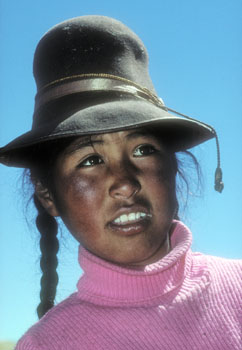Daylight fill-flash is a useful technique for reducing contrast. A dedicated flashgun equipped with a small softbox provides a reasonably diffused controllable light source to fill dark shadows - such as those formed in strong light around the eyes of a person and under their nose and chin. Flash also puts attractive highlights in otherwise dark eyes. In the photograph on the right, the face is illuminated by daylight fill-flash. had the flash nor been used, the girl's face would have been in the shadow of her hat and hence much darker. The sharp, well defined highlights in the eyes have also added sparkle to the image.
 The basic principle of fill-flash is to adjust flash output to balance the ambient light. Foreground subjects and shadows are consequently illuminated to match the wider scene. However, this can produce a rather brash unnatural image. More subtle effects may be realized by using flash compensation - for example, reducing the power of the flash by one or two stops (halving or quartering the output). Precise levels of fill and compensation must be decided with knowledge of the basic flash strategy used by a particular camera. They are also dependent on ambient light, contrast, film latitude, the nature of the subject and the type of image required. In practice, when using a Nikon D3 to photograph a person in strong light, the shadows on black or dark skin might be adequately filled with flash output set about two thirds of a stop below the predetermined balance (-2/3 stop compensation). For a pale or white-skinned subject the level might be reduced to about one-and-a-half stops below the normal balance (-1 1/2 stops compensation). These figures are merely a starting point, and uncertainties remain. People with similar-coloured skins reflect different amounts of light, so bracketing is desirable.
The basic principle of fill-flash is to adjust flash output to balance the ambient light. Foreground subjects and shadows are consequently illuminated to match the wider scene. However, this can produce a rather brash unnatural image. More subtle effects may be realized by using flash compensation - for example, reducing the power of the flash by one or two stops (halving or quartering the output). Precise levels of fill and compensation must be decided with knowledge of the basic flash strategy used by a particular camera. They are also dependent on ambient light, contrast, film latitude, the nature of the subject and the type of image required. In practice, when using a Nikon D3 to photograph a person in strong light, the shadows on black or dark skin might be adequately filled with flash output set about two thirds of a stop below the predetermined balance (-2/3 stop compensation). For a pale or white-skinned subject the level might be reduced to about one-and-a-half stops below the normal balance (-1 1/2 stops compensation). These figures are merely a starting point, and uncertainties remain. People with similar-coloured skins reflect different amounts of light, so bracketing is desirable.
The use of fill-flash implies a number of limitations on normal camera operation. The recharging cycle of all but the most sophisticated flashguns will be much slower than motor-driven film transport or digital sensor recycling so firing rate must reduce. But, more significantly, it is necessary to keep the shutter speed below the camera's flash synchronization speed. Above this speed the trailing blind of a focal plane shutter begins moving before the leading blind has stopped. Exposure is achieved progressively as a narrow opening between the shutter blinds sweeps across the frame. Consequently only part of the frame will be exposed to the comparatively brief burst of flash. This limitation imposes a corresponding restriction on aperture, and hence depth of field.






